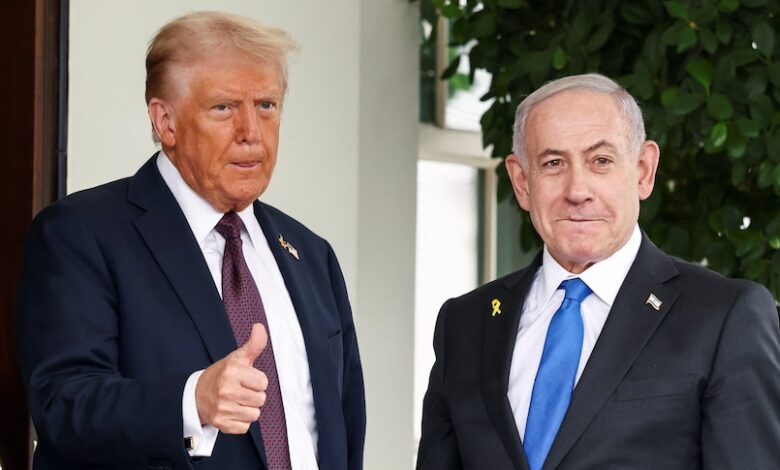Peace or Mandate? Inside Trump’s Controversial Gaza “Peace” Plan

The White House unveiled a 20-point proposal it claims could halt Israel’s genocide in Gaza, which has already killed more than 66,000 Palestinians and left the enclave in ruins. According to the plan, if both sides accept it, hostilities would end immediately. All Israeli soldier prisoners would be released within 72 hours, and Palestinian detainees would be released. A temporary, government would run Gaza, with no role for Hamas or any resistance faction. Israel would not annex the territory.
ICC-wanted Israeli Prime Minister Benjamin Netanyahu has endorsed the plan. Hamas has only received the proposal after Netanyahu approved it.
The plan envisions Gaza as a “deradicalized, terror-free zone” and promises extensive reconstruction, including rehabilitation of hospitals, water, electricity, bakeries, and public infrastructure. Governance would be handled by a temporary international body, the “Board of Peace,” chaired by Trump and including western figures such as Tony Blair. A special economic zone would be created to attract investment, jobs, and development. Hamas and other factions would be disarmed, and those willing to commit to “peaceful coexistence” would be granted amnesty. An International Stabilization Force would oversee security in Gaza alongside trained Palestinian police, ensuring borders remain secure.
Key Terms of the Plan:
- Gaza “redeveloped” for the benefit of its residents, with no military or “terror” infrastructure.
- Immediate cessation of all military operations and frozen battle lines until conditions for withdrawal and Israeli soldier prisoner release are met.
- All Israeli soldier prisoners, alive and deceased, returned within 72 hours of Israel’s acceptance.
- Release of 250 life-sentence Palestinian detainees and 1,700 Gazans kidnapped after October 7, 2023.
- Amnesty and safe passage for Hamas members who commit to “peaceful coexistence” and decommission weapons.
- Entry of international aid through UN agencies, Red Crescent, and other institutions without interference.
- Temporary governance by a technocratic Palestinian committee with oversight by the “Board of Peace.”
- Creation of a special economic zone.
- Free movement for residents wishing to leave or return to Gaza.
- Disarmament of Hamas and other resistance factions, supervised by independent monitors, with weapons buy-back and reintegration programs.
- Guarantees from regional partners that Gaza poses no threat to “neighbors”.
- Deployment of an International Stabilization Force to train and support Palestinian police, secure borders, and facilitate aid.
- Israel’s withdrawal contingent on demilitarization and establishment of security frameworks, with phased handover to the transitional authority.
- Interfaith dialogue to promote “tolerance” and “peaceful coexistence”.
- Conditions for future Palestinian self-determination and statehood once governance “reforms” are implemented.
- US-led dialogue between Israel and Palestinians to establish a long-term political horizon.
Peace or Mandate?
Analysts warn the plan carries serious political and legal risks. Ali Abu Rezeg notes that the plan “is a rollback of Palestinian political and national achievements of decades” and “neutralizes the political and national struggle while emphasizing humanitarian aspects,” effectively sidelining the Palestinian Authority. He adds that “it appears there is a regression from some modifications requested by Arab and Muslim leaders,” leaving Gaza under international technocratic control rather than Palestinian governance.
Analyst Saeed Al-Haj calls the plan “a framework for Palestinian surrender” and says it “aligns with Netanyahu’s previous demands on Hamas,” focusing on coexistence without offering a Palestinian state. He warns that “this is not a real peace initiative, but a mechanism for political marginalization over the long term.”
Writer and political analyst Muhammad Al-Akhras emphasizes that the plan “represents a political overturn of the legal status of Palestinians within the 1967 territories” and “effectively bypasses existing Palestinian institutions.” He notes that “aid and reconstruction are tied to compliance and demilitarization,” reducing Palestinian autonomy and leaving them exposed to continued Israeli control.
Former senior United Nations Official Craig Mokhiber criticizes the plan as “a colonial-style arrangement.” He notes that it “imposes external control over governance, security, and economic development, disarms Hamas and all resistance factions, and guarantees Israeli impunity.” He adds that there is “no accountability for genocide, no dismantling of the criminal regime, no end to apartheid, no reparations for victims, and no Palestinian self-determination.”




